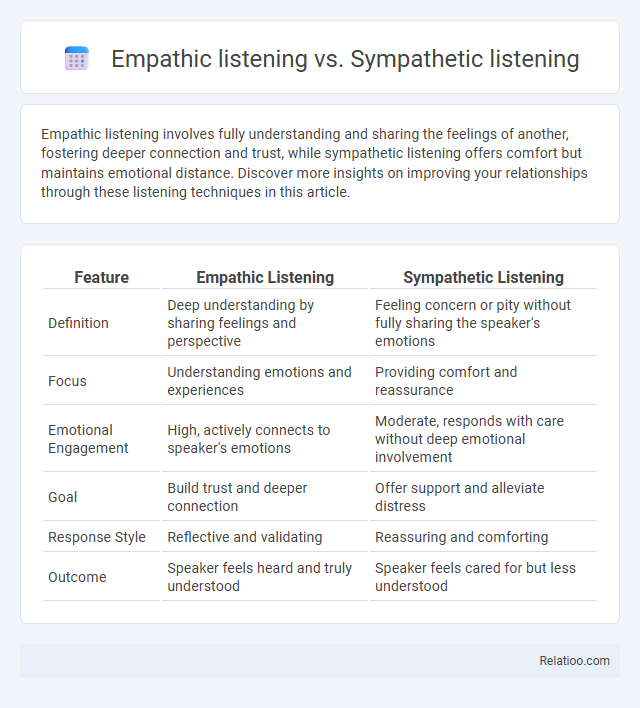Empathic listening involves fully understanding and sharing the feelings of another, fostering deeper connection and trust, while sympathetic listening offers comfort but maintains emotional distance. Discover more insights on improving your relationships through these listening techniques in this article.
Table of Comparison
| Feature | Empathic Listening | Sympathetic Listening |
|---|---|---|
| Definition | Deep understanding by sharing feelings and perspective | Feeling concern or pity without fully sharing the speaker's emotions |
| Focus | Understanding emotions and experiences | Providing comfort and reassurance |
| Emotional Engagement | High, actively connects to speaker's emotions | Moderate, responds with care without deep emotional involvement |
| Goal | Build trust and deeper connection | Offer support and alleviate distress |
| Response Style | Reflective and validating | Reassuring and comforting |
| Outcome | Speaker feels heard and truly understood | Speaker feels cared for but less understood |
Understanding Empathic Listening
Empathic listening involves deeply understanding Your feelings and experiences by actively engaging with the speaker's emotions and perspectives, unlike sympathetic listening, which primarily expresses care and concern without fully grasping the emotional context. This form of listening enhances emotional connection and builds trust by reflecting the speaker's true emotions and validating their experiences. Mastering empathic listening requires focused attention, open-mindedness, and a non-judgmental attitude to accurately interpret and respond to the underlying emotional content in conversations.
Defining Sympathetic Listening
Sympathetic listening involves understanding another person's feelings and expressing compassion without fully engaging in their emotional experience, often leading to offering comfort or reassurance. Empathic listening, in contrast, requires deeply tuning into the speaker's emotions and thoughts, reflecting their perspective to foster genuine connection and validation. While sympathetic listeners may acknowledge emotions, empathic listeners aim to fully experience and communicate an accurate understanding of those feelings.
Key Differences Between Empathic and Sympathetic Listening
Empathic listening involves deeply understanding and sharing the speaker's feelings by fully engaging and reflecting their emotions, fostering a genuine emotional connection. Sympathetic listening, in contrast, focuses on feeling concern or pity for the speaker without necessarily experiencing their emotions or providing validation. The key difference lies in empathic listening's emphasis on emotional resonance and validation, while sympathetic listening centers on expressing compassion or sorrow.
The Psychology Behind Listening Styles
Empathic listening involves deeply understanding the speaker's emotions and experiences by fully engaging with their perspective, which activates brain areas linked to emotion regulation and social cognition. Sympathetic listening, in contrast, involves feeling concern or sorrow for the speaker without necessarily sharing their emotional state, primarily engaging affective neural circuits. The psychology behind these listening styles highlights how empathic listening fosters stronger interpersonal connections and emotional validation by promoting active neural mirroring, whereas sympathetic listening often results in emotional distancing.
Benefits of Empathic Listening
Empathic listening offers profound benefits by enabling deeper emotional connection and understanding, which fosters trust and strengthens relationships. You can validate others' feelings without judgment, promoting a safe space for open communication that enhances conflict resolution and emotional support. Unlike sympathetic listening, which may create distance through pity, empathic listening encourages genuine compassion and active engagement, resulting in improved mental well-being for both parties.
Limitations of Sympathetic Listening
Sympathetic listening often leads to offering comfort and reassurance without deeply understanding the speaker's emotions, which can limit genuine connection and emotional validation. This approach may inadvertently dismiss or oversimplify complex feelings, causing the speaker to feel misunderstood or unsupported. Empathic listening, by focusing on truly experiencing and reflecting the speaker's emotions, overcomes these limitations by fostering trust and deeper emotional engagement.
When to Use Empathic vs Sympathetic Listening
Empathic listening is essential when understanding another person's emotions deeply and providing genuine support, especially in situations requiring emotional validation and trust-building. Sympathetic listening is more appropriate for offering comfort or expressing concern from a more distant perspective without fully immersing in the speaker's feelings. Use empathic listening for conflict resolution, counseling, or when fostering strong interpersonal connections, whereas sympathetic listening suits brief interactions or when emotional involvement is limited.
Common Misconceptions About Listening Types
Empathic listening is often confused with sympathetic listening, yet empathic listening requires fully understanding and sharing the speaker's emotions without judgment, whereas sympathetic listening involves feeling pity or sorrow for their situation. A common misconception is that active listening and empathic listening are the same, but active listening emphasizes attentiveness and feedback while empathic listening prioritizes emotional connection and perspective-taking. Many assume that sympathetic listening is less supportive, but it can provide comfort by expressing care, though it lacks the deep emotional resonance that defines empathic listening.
Real-Life Examples of Empathic and Sympathetic Listening
Empathic listening involves deeply understanding and sharing the feelings of another person, such as when a counselor actively listens to a client's emotional pain without judgment, creating a safe space for healing. Sympathetic listening, on the other hand, entails feeling concern or pity, like when a friend hears about your bad day and offers comforting words without fully engaging in your emotional experience. You can recognize empathic listening in real-life situations where the listener validates your emotions and mirrors your feelings, fostering genuine connection and support.
Strategies to Improve Empathic Listening Skills
Empathic listening involves fully understanding and sharing the feelings of another person, whereas sympathetic listening focuses on feeling pity or sorrow for someone's situation without deeply engaging emotionally. To improve your empathic listening skills, practice active listening by giving your full attention, using nonverbal cues like nodding, and asking open-ended questions that encourage elaboration. Developing emotional intelligence through mindfulness and self-awareness enhances your ability to connect genuinely with others' experiences.

Infographic: Empathic listening vs Sympathetic listening
 relatioo.com
relatioo.com